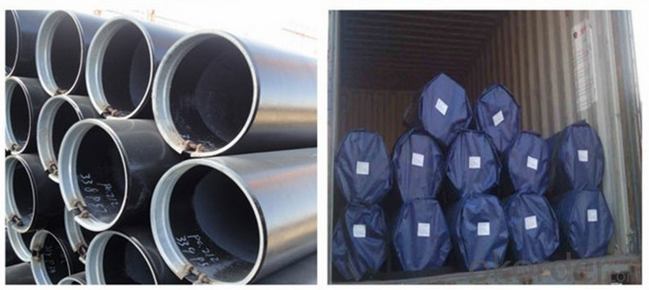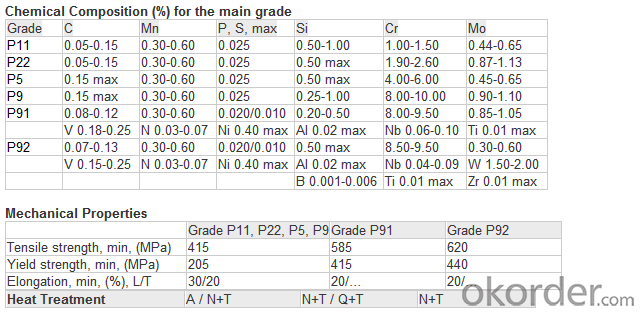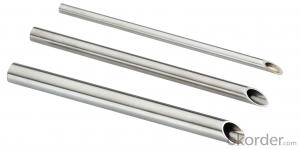Stainless Steel Sheet for Standard 200,300,400 Series
- Loading Port:
- Shanghai
- Payment Terms:
- TT OR LC
- Min Order Qty:
- 1000 kg
- Supply Capability:
- 10000 kg/month
OKorder Service Pledge
OKorder Financial Service
You Might Also Like
Packaging Detail: | Bundle or Container or as per customers requirement. |
Delivery Detail: | within 25 days after we receive an irrevocable L/Cor 30% deposit |
ASTM A335 Seamless Alloy-Steel Pipe
Standard: BS 1139, BS 3059-2, JIS G3454-2007
Grade: 10#-45#, 15NiCuMoNb5, 10Cr9Mo1VNb
Detailed introduction to ASTM A335 seamless alloy steel pipe:
ASTM A335 seamless alloy steel pipe


FAQ:
1) why you chose us ?
Professional Manufacturer and supplier of Steel pipe
More than 14 years’ professional producing experience
We can get the lowest ex-factory prices. The price are quite reasonable and it is lower than our commercial peers. also, we can guarantee the qualities of our products.
BV, ISO certificates and SGS test can be provided to assure the quality of our products.
2) Our minimum order quantity:
10 Metric Tons or one 20ft or 40ft Container.
3) How about the Delivery Time?
The steel pipe will be produced since we getting your deposit by T/T or Your original L/C. For normal size, some stocks in our factory now, we can supply once you need.
4)What kind of payment does your company support?
T/T, 100% L/C at sight, Cash, Western Union are all accepted.
5) Do you charge for the samples?
According to our company principle, we just charge for samples, you pay for the freight /courier charge.
6) Main market:
Mid East, South America, Africa, Southeast Asia, India etc
- Q:Can stainless steel pipes be insulated with polybutylene?
- No, stainless steel pipes cannot be insulated with polybutylene. Polybutylene is a type of plastic material that is commonly used as a water supply pipe. It is not suitable for insulating stainless steel pipes. Stainless steel pipes are already highly resistant to corrosion and do not require additional insulation for thermal purposes. If insulation is needed for stainless steel pipes, other materials such as fiberglass or foam pipe insulation can be used.
- Q:What is stainless steel pipe?
- Stainless steel pipes, crafted from a steel and chromium alloy, boast exceptional resistance to corrosion and oxidation. Their durability, strength, and aesthetic appeal make them a popular choice across industries like construction, automotive, and manufacturing. These pipes have the ability to withstand high temperatures and pressure, making them ideal for fluid and gas transportation. Moreover, they come in a range of sizes, shapes, and grades to cater to individual needs. Whether in residential or industrial settings, stainless steel pipes find extensive use in plumbing, water supply systems, HVAC systems, and various other applications where durability and corrosion resistance are paramount.
- Q:Can stainless steel pipes be used for architectural applications?
- Stainless steel pipes are applicable for architectural purposes, offering a multitude of advantages. With its durability and versatility, stainless steel proves to be a reliable material. Its corrosion resistance makes it ideal for outdoor use, even in harsh weather conditions. Moreover, stainless steel pipes contribute to the aesthetic appeal of architectural designs, providing a modern and sleek look. They can be utilized for various architectural elements, including handrails, balustrades, structural supports, and decorative features. Additionally, their strength and reliability make them suitable for load-bearing applications, ensuring the safety and stability of architectural structures. Overall, stainless steel pipes are a popular choice for architectural applications due to their functionality, durability, and aesthetic appeal.
- Q:Where is the difference between seamless steel pipe and welded pipe?
- Seamless steel tube is formed during rolling. Welded steel pipes need to be welded after coiling, and spiral welding and direct welding are generally used. Seamless performance is better, of course, the price is higher.
- Q:What is the difference between 304 and 316 stainless steel pipes?
- The main difference between 304 and 316 stainless steel pipes lies in their composition. While both alloys are corrosion-resistant, 316 stainless steel contains higher levels of molybdenum and nickel, making it more resistant to pitting and crevice corrosion in chloride environments. Additionally, 316 stainless steel offers better overall corrosion resistance and increased strength at elevated temperatures compared to 304 stainless steel pipes.
- Q:What is the difference between seamless and HFW stainless steel pipes?
- The manufacturing process and the presence of a welded seam distinguish seamless stainless steel pipes from HFW (High Frequency Welded) stainless steel pipes. Seamless stainless steel pipes are created by piercing a solid billet or ingot and rolling it into a cylindrical shape. This method eliminates the need for welding, resulting in a pipe without any seams or joints. The absence of a welded seam enhances the overall strength and integrity of the pipe, making it ideal for high-pressure applications. On the contrary, HFW stainless steel pipes are produced using high-frequency electric resistance welding. This process involves passing a flat strip of stainless steel through a series of rollers and longitudinally welding it using a high-frequency current. The welded seam is then heat-treated to ensure the same corrosion resistance as the base material. HFW pipes are generally more cost-effective compared to seamless pipes, making them a popular choice for various applications. While both seamless and HFW stainless steel pipes offer excellent corrosion resistance and durability, seamless pipes are often preferred in critical applications where high strength and reliability are essential. The absence of a welded seam minimizes the risk of leakage and failure, making them suitable for industries such as oil and gas, petrochemical, and nuclear power. HFW stainless steel pipes, on the other hand, are more commonly used in less demanding applications like water supply, plumbing, and construction. They provide a cost-effective solution without compromising overall performance and corrosion resistance. In conclusion, the main difference between seamless and HFW stainless steel pipes lies in their manufacturing process and the presence of a welded seam. Seamless pipes are produced without welding, offering superior strength and reliability for critical applications. HFW pipes, on the other hand, are manufactured through high-frequency electric resistance welding and are more cost-effective, making them suitable for less demanding applications.
- Q:Can stainless steel pipes be cold worked?
- Yes, stainless steel pipes can be cold worked. Cold working is a process that involves deforming the metal at room temperature, without the need for heating. Stainless steel, being a versatile and ductile material, can be easily cold worked to achieve desired shapes and sizes. Cold working methods such as bending, flaring, swaging, and drawing can be applied to stainless steel pipes to meet specific requirements. Cold working also enhances the strength and hardness of the stainless steel, making it suitable for various applications in industries such as construction, automotive, and manufacturing.
- Q:Difference between stainless steel and steel pipe
- 2. welded steel pipe for different welding process and divided into the furnace pipe welding (ERW) pipe and automatic arc welding, because of the different forms of welding seam welded pipe and spiral welded pipe is divided into two kinds, end its shape is divided into circular welded and shaped (square, flat) pipe.The welded pipe is rolled into the steel tubular to sew or spiral seam welded in the manufacturing method, and is divided into low pressure fluid delivery with welded steel pipe, spiral welded steel pipe, welded steel pipe, welded pipe roll etc.. Seamless steel pipe can be used in various industries, such as liquid, pneumatic, pipeline and gas pipeline. Welding pipes can be used in water pipelines, gas pipelines, heating pipes, electrical appliances, pipelines and so on.
- Q:Can stainless steel pipes be used for chemical processing applications?
- Yes, stainless steel pipes can be used for chemical processing applications. Stainless steel is known for its excellent corrosion resistance, making it suitable for handling various chemicals and corrosive substances. It is resistant to both organic and inorganic chemicals, including acids, alkalis, and solvents. Additionally, stainless steel pipes have high strength and durability, allowing them to withstand high temperatures and pressures commonly encountered in chemical processing operations. The smooth inner surface of stainless steel pipes also prevents the accumulation of deposits and ensures the efficient flow of chemicals. Overall, stainless steel pipes are a reliable choice for chemical processing applications due to their corrosion resistance, strength, durability, and ease of maintenance.
- Q:How are stainless steel pipes joined or connected?
- Various methods are employed to join or connect stainless steel pipes, depending on the specific application and requirements. Welding is a commonly used technique, in which the pipes are fused together using heat to establish a robust and enduring connection. This can be accomplished through different welding methods, including TIG (Tungsten Inert Gas) or MIG (Metal Inert Gas) welding. Another approach involves threading the ends of the pipes and subsequently fastening them together using pipe fittings. This method is particularly favored for smaller diameter pipes or situations that necessitate disassembly. Additionally, compression fittings can also be utilized to connect stainless steel pipes. This involves the use of a compression ring or ferrule to create a tight seal between the pipes. This method is often employed when connecting pipes with larger diameters or when frequent disassembly is required. Ultimately, the choice of joining or connecting method for stainless steel pipes relies on the specific project requirements, such as pipe size, pressure, temperature, and the need for disassembly.
1. Manufacturer Overview |
|
|---|---|
| Location | |
| Year Established | |
| Annual Output Value | |
| Main Markets | |
| Company Certifications | |
2. Manufacturer Certificates |
|
|---|---|
| a) Certification Name | |
| Range | |
| Reference | |
| Validity Period | |
3. Manufacturer Capability |
|
|---|---|
| a)Trade Capacity | |
| Nearest Port | |
| Export Percentage | |
| No.of Employees in Trade Department | |
| Language Spoken: | |
| b)Factory Information | |
| Factory Size: | |
| No. of Production Lines | |
| Contract Manufacturing | |
| Product Price Range | |
Send your message to us
Stainless Steel Sheet for Standard 200,300,400 Series
- Loading Port:
- Shanghai
- Payment Terms:
- TT OR LC
- Min Order Qty:
- 1000 kg
- Supply Capability:
- 10000 kg/month
OKorder Service Pledge
OKorder Financial Service
Similar products
New products
Hot products
Related keywords




























